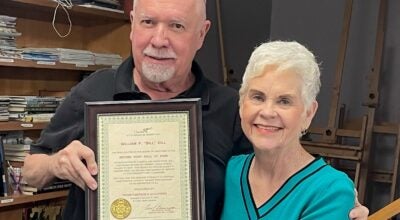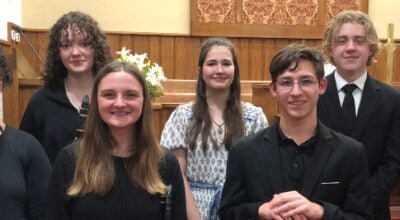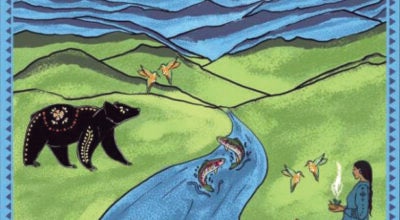Janet Orselli &Rema Keen present creative Feats
Published 8:00 am Friday, May 22, 2009
There&squo;s a fun collection of Feats currently at the Upstairs Artspace. Tonight the installation will come alive with an active performance blending the artwork of Janet Orselli with the storytelling of Rema Keen. I met with both artists at the Gallery Coffeehouse to find out more about how this collaboration came to life. What was the genesis for this idea? Janet: As we&squo;ve collaborated it&squo;s become an entity of its own. People might not see a total direct connection between the work and the performance that we do. A mutual friend said, &dquo;Oh, you&squo;re an installation artist? I know a woman who&squo;s a performance artist. You guys should get to know each other because you&squo;re in the same general vicinity.&dquo; Rema: Janet called me one Saturday. My friend had emailed me to let me know she&squo;d given Janet my phone number and we talked for a while on the phone. Then a few days later I invited her out to my house. We had talked for a few hours, then 30 minutes on the phone, and the next day Janet said, &dquo;Let&squo;s do something together.&dquo; I said, &dquo;Okay.&dquo; We talked about it and that&squo;s how it initially began. According to Janet&squo;s email, you just met at the end of March this year. &bsp;So, it was from this mutual friend introducing you that you decided to do something together? Janet: I&squo;ve done performances as part of my installations in the past. Each time it started out as just me doing the performance and then I started encouraging other people to do parts of it, but I&squo;ve never actually collaborated with someone as far as planning it and putting it together. When you got together and decided you wanted to do this, what were some of the key ideas you decided you wanted to play with? Janet: Well, humor certainly as well as tying in to the art work. The idea of transformation and moving on, because it&squo;s all about feet, the feet had to be pretty important. Feet are a symbol, kind of a metaphor for not getting stuck in the past, moving forward going on to the next great adventure. Rema: There are a lot of different levels with feet and we&squo;re having a good time with it. We talked about how we each do performances and what they entail. It&squo;s been really interesting for me, I&squo;ve learned a lot from Janet about her work. When she first said, &dquo;I&squo;m an installation artist,&dquo; I thought she installed plants in landscape. We started to find threads of commonality in our work. We both wanted to involve other artists and learn more about each other&squo;s art work. Storytelling is very audience interactive and about being right out there. She tells a story one way with her art work and I tell a story another way with mine. Combining them is just the next step. Janet: I&squo;ve always been looking recently for ways to involve the audience more in my work and not be so distant from them. A lot of times I&squo;m unable to hear the reaction of the audience to my work because I&squo;m not right there to come and see it. This is a way to share the work in a different art form, and share what is behind it without it being a secret. It makes it more accessible. When people come to this performance what are they going to see? Rema: A little of both. Of course they&squo;re going to view Janet&squo;s work upstairs. The performance will be downstairs. It is going to be storytelling. It&squo;s going to be poetry, some movement, and gosh, it&squo;s just going to be some fun, a lot about feet. This is going to be the first step in hopefully maybe a bigger collaboration. We&squo;ve had a very short time to put something together so this is a piece of a work in progress. Next time we&squo;ll do something on a larger scale. This is an experiment. Do both of you live in the Tryon area, or are you commuting in because this is where the space is? Janet: I live in Mill Spring which is not far. Rema: I live in Campobello. Is it because Upstairs Artspace had the space and they wanted to do the show? Janet: I only really found out about my part of the show maybe two months ago. This is really quickly put together. Then it was a week later that I contacted Rema. It&squo;s only been a month and a half that we knew that we were going to do this. It&squo;s going to be fresh. Have you done shows with the Upstairs Artspace before? Janet: Yes, at their grand opening in the new space I had an installation in the whole downstairs. This is a continuation of that relationship. Rema: Before that in the mid &squo;90&squo;s I&squo;d done some things with performances in the Upstairs when it was at the other location. What are your backgrounds that led you to be ready to collaborate at this point? Janet: Well my early background is an undergraduate in psychology. In 2oo1 I got my MFA from Clemson and began immediately focusing on installation art. Pretty much that&squo;s what I&squo;ve done since 2001 is work as a professional artist and focus on art doing installations in different museums and places. Do you find that the psychology degree feeds into your artwork? Janet: Oh, yes. There are always themes that run through it that relate to relationships and human connections. Do you think people will learn something more from your artwork than they would if they sat down with you in an analyzing session and talked through it all with you? Janet: That&squo;s a good question. It&squo;s just another form of communication that I see. It&squo;s a different way to communicate. I learn more about myself and even about people through making the art and interacting with people about the art. It&squo;s just a very unique form of communication. And you Rema? Rema: I went to college in Virginia and I got degrees in English Literature and Theatre. I travelled for many years in my twenties with the Roadside Theatre out of the Appalshop in Kentucky. Then I started my own theatre company with another woman called Too Many Hats. We toured for a while. I toured two one-woman shows, one of which I co-wrote based on the life of my grandmother. I&squo;ve done theatre in one form or another pretty much all of my life. I&squo;ve kept my finger in it. When I moved here I got out of the loop. I&squo;ve done lots of other jobs. As an artist I&squo;m sure you know there&squo;re a lot of different things you have to do if you don&squo;t do your art. I&squo;m on the South Carolina Roster of Teaching Artists. I&squo;m in the schools sometimes. My main business is a greenhouse business. I grow perennials and herbs. That&squo;s what my day job is and I just do this when I can. In the last few years I&squo;ve been concentrating on getting back into the art full time, storytelling and writing more. When it&squo;s in your blood, if you don&squo;t do it you think whatever else you do is not your real job. I should be an artist. I understand that frustration. It&squo;s like sitting at someone else&squo;s computer answering emails I don&squo;t care about. Rema: When that novel is sitting on your desk at home. Janet: It&squo;s that desire to share that creative process with other people at a certain level that sometimes we miss in this day and age where we don&squo;t have as much direct connection with other people. I think that&squo;s why I want to get more involved with performance as a way to work directly with people about ideas, feelings, culture, what&squo;s going on, and to find ways to help people to tell their stories. I feel like that&squo;s what I&squo;m doing through my art, I&squo;m telling a story about myself and sometimes as I&squo;m making the work I don&squo;t know what it means until I get to the end. Other people tell me, &dquo;Oh, I see this in it and I see that in it.&dquo; I&squo;m putting the pieces together and saying, &dquo;Oh wow! That&squo;s about
this larger picture and myself and my place in the world.&dquo; There&squo;s a desire now at this point to bring other people into that process. A start is to work with Rema as well as to find ways to use that in the community. To encourage the community to be more involved in telling their story. This community has such great possibilities because it&squo;s a small town and there are all these connections and history. It has this southern quality where storytelling is such a big part of being here in this rural setting. I just really want to enlarge the whole process and this is really just the beginning. Rema: I think that&squo;s where Janet and I connect is on that level. With storytelling theatre whether in the schools with fifth graders telling stories about their scars, or with the community of older people at Tryon Estates telling their stories. Behind every scar there&squo;s a story. I think that&squo;s where they connect. One of my favorite sayings is, &dquo;In the specific you find the universal.&dquo; I found that in telling my grandmother&squo;s story about being a coal miner&squo;s wife and her husband was killed in the coal mines leaving her with seven kids in his wake. Every time I told that story it never failed, where ever I was. Whether I was in Virginia in the coal fields or if I was in California somebody would come up and make a comment like, &dquo;My grandmother told stories just like that,&dquo; or &dquo;My grandfather died that way.&dquo; In the specific story about my grandmother people could relate to different aspects of it just in the telling. Janet: I want to include the objects too. I think some people have stories within the objects, or they inspire stories. Especially old and worn objects, because just like a person that gets older this object has had a history too and becomes a symbol for people. For instance, let&squo;s say an old shoes they have this history, somebody owned them, somebody wore them and you know the old roller skates and all of that. I&squo;m thinking, I have a project that I did with some students to write stories where I brought out all of these old objects and they would pick an object. They would use that as a basis for a story. Either they would pretend they were the object and write from the object&squo;s point of view or they would pretend that they had owned the object and what had happened to that object. I just like this combination of storytelling with using objects as inspiration or using objects in a play or something that is performed. We&squo;re kind of throwing around those idea of how to my use of objects and Rema&squo;s storytelling into a whole. Do you think you&squo;ll travel with this after your first performance here at the Upstairs? Rema: Maybe, yeah. If we can get it up and going I think we would like that. Janet: That would be fun. Even with the same installation I&squo;ve had people come in with totally different experiences based on their own experience. I&squo;ve had people come in and see all these old objects and say, &dquo;Oh, that&squo;s so depressing.&dquo; While other people say, &dquo;This is the most comforting space. I feel so at home.&dquo; It is just amazing how people bring their own experience and background with them and the expression of how that space made them feel, or what memories it brought up. It&squo;s really interesting to hear people&squo;s perspective on that. Rema: With storytelling, being on the stage, the audience is so much a part of the story. The way we do this is very minimal. The audience has to use their imagination and you have to put yourself out of the way to tell the story. It is interesting in every space when you start telling the story how you connect with the audience. You can feel it immediately if they&squo;re with you. It does make a difference in the space and the town. Beat It mixed media by Janet Orselli (photo submitted)&bsp;Shall we wander down and look at the work? The first thing that catches my eye is an old turtle shell, piano hammer and skate. Janet: I have always loved turtles. They&squo;re very symbolic to me. I like the combination of the slowness of the turtle and the roller skate. The turtle wants to go faster and accomplish things. Is that a skate key you&squo;re wearing around your neck? Janet: Yes, I thought it was fun. I don&squo;t think it would even work because it&squo;s so rusty, but I like the idea of it. The number one song on the charts the day I was born was Brand New Key by Melanie even though I never had a pair like this. Janet: Oh, I did. I can&squo;t believe they allowed it. They look like torture instruments, don&squo;t they? That&squo;s what I like about them too. It&squo;s back in time. A different age, different time, different way of doing things people didn&squo;t worry about it. I don&squo;t think parents would let kids go on these skates today. It&squo;s dangerous, you&squo;d hurt yourself. Janet: You have to be protected. These started out as just fun things I was doing in my studio because I didn&squo;t have enough space to work. This work is much smaller. My website will show you the larger installations. These are more a focus on individual works. Most of my works are a room you enter where it&squo;s like a space. It&squo;s like a room in someone&squo;s house maybe with odd things in it. This is more of a display that what I usually do, with more focus on individual objects. Yet, I think they speak to each other. They&squo;re connected. Heavy Load, Beat It, these are just fun! Where do you find all this? Did you scavenge every thrift store for roller skates? Janet: It&squo;s so much fun naming them after the fact, to try to find something funny. I find that I can&squo;t plan ahead what I&squo;m going to do. I&squo;m just open to whatever seems to speak to me. I just went through this series of everywhere I would go I&squo;d find these old roller skates and I&squo;d find these old, I think they&squo;re called a shoe lass. I don&squo;t even know if they still use those. I kept finding those and thought, &dquo;These seem to be coming up so how can I use them?&dquo; These are child size. I remember my dad had one that had a metal extension but part if it was wood. Janet: Those may be more like shoe trees to keep the show stretched. I have one whole series of pieces where I used old crutches. These are kind of connected to that same idea of motion and movement. SinkOr makes me think of Wynken, Blynken, & Nod in their little shoe boat. Janet: I like to play off of a lot of children&squo;s themes and the idea of these almost as if they&squo;re toys, but yet their not toys. They have a serious quality, but yet a fun quality too. If I was a kid and walked into a house and saw them I&squo;d want to play with them. Janet: I would have been curious to see the fourth graders Cindy brought. I bet that was a challenge for them not to touch them. It&squo;s interesting to see how there are similar pieces, but each has its own unique thing going on with it. The piano hammers appear in a few, but never doing the same thing. Janet: Sometimes by the title I make sense of what it&squo;s about, but it&squo;s also about the combination of all of them together. That&squo;s why even though they&squo;re displayed almost as individual items I think of them as a whole. Each is like a unique individual and maybe some part of them is being represented by the piece. Like Beat It, &dquo;we need to speed up and get going faster,&dquo; or Put Your Foot Down, &dquo;we need to put a stop to this.&dquo; Guilt is has the gavel coming down on your toe. Feats Installation mixed media by Janet Orselli (photo submitted) People will come in for the show and they&squo;ll be able to see this up here, but the actual performance will be downstairs. Janet: I think most of them are going to stay up here, but I
&squo;ve got related objects that we&squo;ll have down there that will be part of the performance. It&squo;ll have some connections. How many people do you think will fit downstairs? Janet: I know they have sixty chairs. If people want a chair they need to be one of the first 60 people down there. Janet: Yeah, and the doors open at 6:20 p.m. We&squo;ll have some really light refreshments and hopefully we can get started right at 7 p.m. with the performance. This is a one night only performance this evening and a chance to see two intriguing local artists join together in pushing the boundaries of their crafts together. For more information about Janet Orselli&squo;s work visit her website www.janetorselli.com. You can also reach the artists by phone or email Janet at 828-899-8021 or jorselli@hotmail.com and Rema at 864-978-1615 or rema27@windstream.net.





